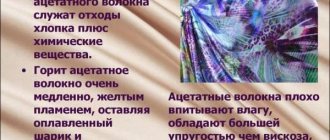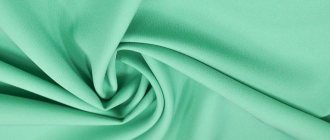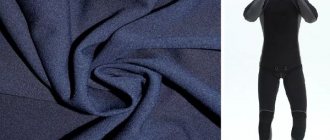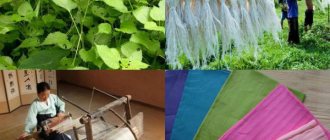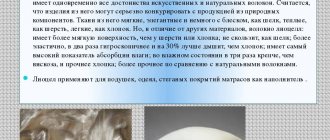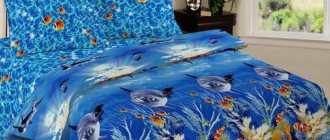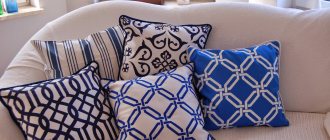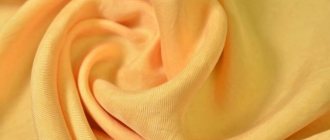One of the fabrics that combines the positive qualities of synthetics and natural ones is acetate. Its name will mean nothing to many, although it is quite common. So what kind of material is this with such a strange name, let’s figure it out.
Acetate was invented in England at the beginning of the last century; it is a fiber produced from cellulose using a special technology using chemical reagents - cellulose acetate. To obtain it, a dry method is used, and acetone is used as an organic solvent.
Acetate fabric – what is it, description
Unlike synthetics obtained from chemical compounds, acetate is a successful symbiosis of natural raw materials and reagents. To prevent the fabric from becoming electrified, the resulting thread is specially treated before weaving. Acetate lends itself well to coloring, which allows you to obtain a large number of bright shades.
In terms of its properties, acetate fiber is superior to ordinary viscose; it is more elastic, stronger, softer to the touch and less wrinkled, with a characteristic silky sheen. Acetate fabrics resemble natural silk in appearance and tactility, and the cost of production is much lower, as is the selling price.
Properties and characteristics
The properties of the British invention explain its popularity.
- Decorative - duplicating silk, allows you to sew beautiful things.
- Elastic - holds its shape well, which simplifies care and allows things to always look good.
- Pleasant – it does not create discomfort on the body; on the contrary, it is very pleasant to wear.
- Hypoallergenic - the viscose base is neutral, even allergy sufferers with sensitive skin can easily come into contact with acetate.
- Unpretentious - easy to wash, does not require special care, but you should handle it carefully, it is weak to tear when wet.
- Breathable - allows air to pass through well, but practically does not absorb moisture.
- Affordable - looks like silk, feels like silk, and costs significantly less.
Application
The characteristics of the fabric predetermined the scope of its application: consumer goods. All kinds of clothing and household items are sewn from it.
- Underwear, including everyone's favorite skimpy nightwear, negligees and dressing gowns.
- Outerwear.
- Bed sheets.
- Furniture covers.
- Curtains.
Areas of use
Read about: viscose - what kind of fabric: varieties and quality differences
Artificial silk is still in great demand today. Acetate fibers are used both in pure form and as part of mixed fabrics: with wool, velvet, gabardine and crepe.
Acetate adds elasticity and strength to products, eliminates the formation of pilling and prevents shrinkage.
1Acetate is an excellent material for clothing. Acetate fabrics are used to make beautiful outerwear and underwear; they are good as linings for jackets, skirts, dresses and trousers. Although 100% acetate is not often used in clothing, it is well suited for raincoats and wonderful stage decorations. 2Acetate material is characterized by rapid drying, which makes it possible to produce umbrellas, swimsuits and curtains for bathrooms. 3Luxurious shine and pleasant coolness to the touch are used to create wonderful home textiles: sets of silky bed linen, decorative pillows, exquisite bedspreads, curtains for bedrooms and living rooms. 4Acetates are often found in upholstery materials. Recommended for use in spacious rooms with high ceilings.
A type of artificial silk - a fabric called "ombre" - has a graduated color and is widely used for decorating rooms and sewing original clothes.
Types: triacetate, silk acetate
Acetate fabric is divided into acetate and triacetate, they differ in the production method and the solvents used, but the resulting material is almost identical. With similar, positive characteristics mentioned above, it also has the same disadvantages.
- Wears out quickly.
- Electrifies despite treatment.
- It loses its appearance as it is washed.
- Weak to tear.
To improve the properties, manufacturers introduce artificial or natural fibers into the acetate composition. This increases the strength of the fabric, extends its service life and prevents damage during washing. Acetate is usually combined with polyester, although a combination with cotton or wool is also found.
Both acetate and triacetate are also called artificial or acetate silk, due to their external similarity and some common properties. To obtain the fabric, acetate fiber is woven in a special way so that the surface acquires a characteristic shine and silkiness.
Video: types of acetate material
On video - a film about acetate fiber:
History of acetate fiber production
Acetate was created in England at the beginning of the twentieth century. The company, which first produced thin, shiny acetate fiber from purified cellulose and cotton fluff, in those years was engaged in the production of varnishes for the needs of aircraft construction. The random experiment was picked up by many manufacturers, and an amazing fabric came into the world, which, due to its extreme similarity to natural material, began to be called acetate silk. This is completely justified, because with natural material it is united by a characteristic shine, elasticity, extreme pleasantness to the touch and the fact that both materials cannot stand a hot iron.
The peak popularity of material came in the post-war years, when there was a huge need for beautiful, but cheap products. Since the 1960s, acetate began to be replaced by a variety of synthetics, and interest in it faded somewhat.
The modern world of textiles is quite loyal to this material. Strong, shiny fibers not only make up pure acetate fabrics, but are also contained in many fabrics, significantly improving the quality of products.
Fiber production, formula
To produce silk acetate, raw materials (cellulose acetate or cellulose acetate ester) are dissolved in acetone. Afterwards, the mass is heated, the acetone evaporates, and the base is passed through a very thin filter, solidifying into threads. They are further processed, twisted and then woven into fabric.
Even a schoolchild with a little knowledge of chemistry can easily read the formula for acetate silk; it looks like this: [C6H7O2(OH)3-x(OCOCH3)x]n .
If you try, you can actually get acetate silk even in laboratory conditions in a lesson, so it is not difficult on a production scale. The formula may be slightly modified, depending on the modifiers used in production, designed to improve the quality of the thread and the performance of the finished fabric.
Fabric roller blinds for windows can be of different colors.
What is taffeta fabric? Read the description.
Photo of Roman blinds on the balcony: .
History of creation
In Great Britain at the beginning of the 19th century. two brothers Henry and Camille Dreyfus invented acetate yarn. At the very beginning, this fabric was used for sewing clothes, as well as for the manufacture of various household products and even for the military. After many centuries, the scientific experts of the Dreyfus company updated the technology, introduced their own developments and innovations, and thus acetate fabric began to be produced in the form of luxurious shiny threads, very reminiscent of silk.
It should be noted that sewing clothes and things from acetate was not easy, since textile companies had difficulty finding the right dye. Later, when it was possible to develop and find a production technology, this fabric gained popularity all over the world as a self-sufficient material, and as a component that can be added to some mixed fabrics.
Interestingly, the name “acetate” itself has Latin roots. “acetum”, which literally translates as vinegar and this is not surprising, since in order to make acetate cellulose acetate is needed, for this purpose the cellulose is exposed to acetic acid.
How to distinguish from nylon and natural silk
How to distinguish acetate and natural silk? Although artificial silk resembles natural silk, it can be distinguished by knowing some subtleties.
- If you separate several threads and set them on fire, the natural ones will smell like burnt hair and will burn into ash, which can be easily rubbed between your fingers.
- Silk made from acetate, although not much, wrinkles if you squeeze the fabric in your fist and then straighten it, traces of folds will be visible on acetate, but on natural they will almost even out.
- Natural silk applied to the body will almost instantly equalize the temperature, acetate silk will remain cool longer, and, whatever one may say, the silkworm derivative is more pleasant to the touch.
- Nylon can be distinguished from acetate by touch; it is rougher, not as elastic and soft. After drying, nylon does not require ironing, but silk will have to be ironed at least slightly.
- Nylon has a coarser weave of threads; they do not fit so tightly to each other, so the surface is slightly rough, while silk is perfectly smooth and soft.
- When compressed, nylon produces a characteristic crunch, but acetate does not.
- Artificial silk is dissolved with acetone, and nylon with acid.
How to choose curtains for a living room in a modern style?
Reviews of the Ikea bandblad pillow: .
Is it possible to hang roller blinds on a doorway?
Acetic Acid and Acetates
Handrails for wooden stairs: design requirements and practical tips
When the negatively-charged acetate anion combines with a positively charged cation, the resulting compound is called an acetate. The simplest of these compounds is hydrogen acetate, which is commonly called acetic acid. The systematic name of acetic acid is ethanoate, but the name acetic acid is preferred by the IUPAC. Other important acetates are acetate of lead (or sugar of lead), chromium(II) acetate, and aluminum acetate. Most transition metal acetates are colorless salts that are highly soluble in water. At one time, lead acetate was used as a (toxic) sweetener. Aluminum acetate is used in dyeing. Potassium acetate is a diuretic.
Most acetic acid produced by the chemical industry is used to prepare acetates. Acetates, in turn, are primarily used to make polymers. Nearly half of acetic acid production goes to preparing vinyl acetate, which is used to make polyvinyl alcohol, an ingredient in paint. Another fraction of acetic acid is used to make cellulose acetate, which is used to make fibers for the textile industry and acetate discs in the audio industry. In biology, acetates occur naturally for use in biosynthesis of more complex organic molecules. For example, bonding two carbons from acetate to a fatty acid produces a more complex hydrocarbon.
Product care
Whether clothing or household items made of acetate fiber, it is necessary to take care of them taking into account their characteristics.
- Wash by hand or on delicate cycle, but hands are better.
- Use only neutral detergents; when rinsing, it is better to use softening additives.
- Dry without using heating devices, in the air, carefully hanging and smoothing with your hands.
- If necessary, ironing is done from the wrong side and preferably through a damp natural fabric.
The disadvantages of a rather finicky material are corrected by its ability to repel dust and dirt. Although linens and clothes will need to be washed frequently, furniture covers and curtains will hang for months without the need for cleaning.
Acetate is not the easiest fabric to use, but the difficulties with its use and short eyelids are more than compensated by its stunning appearance. And it’s a pleasure to wear on your body, and sleeping on silk sheets, even if artificial, will be serene on a summer night. It is enough to follow the care recommendations to ensure that your items last and remain beautiful for as long as possible.
Reviews of artificial silk bedding can be found here.
Why are chemical analogues of natural material called silk?
The established designation - silk fabric, no longer confuses anyone, even if the buyer purchases a product that is the result of achievements in the chemical industry. But still, ideally, only material made from the protein threads of the cocoon of a silkworm caterpillar can be called this: mulberry or oak. And all other varieties would be more correctly called fakes, then there would be no need to add the prefix word “natural” to real silk.
If you approach the question of whether a particular material belongs to silk from a chemical perspective, then their difference in molecular structure immediately becomes obvious. And if you try to synthesize in a laboratory the protein structure of the vital product of a unique butterfly, then the output may be an identical material, the cost of which will be many times higher than the price of natural raw materials.
It is impossible to combine the entire range of this type of fabric and weaving. There are a huge number of varieties obtained using different weaving methods. For example, satin is characterized by satin weave, twill - twill, etc., but all these fabrics are classified as silk.
And yet why are all these species combined into one large group? Let's try to understand this issue step by step. In first place, you can put the aesthetic component based on visual perception (for example: I see - it’s made of silk). The second connection criterion can be the consumer’s tactile perception of a particular type (for example: to the touch I feel that this is a silk thing). The considered aspects are unifying factors for all segments of silk groups and related subgroups, regardless of what the material is made from.
Let's summarize. Color design, shine or dullness, elasticity, resilience, iridescence, hardness or softness and other characteristics will be the conditions that unite silk fabrics according to aesthetic criteria, that is, the unification should be sought in the consumer (associative) properties of this large group.
Advantages and disadvantages
First, about the benefits of artificial silk:
- looks like natural;
- its elasticity exceeds viscose, but is inferior to natural silk;
- soft, pleasant to the touch;
- environmentally friendly, as it consists of natural raw materials, that is, wood pulp or cotton production waste;
- crease resistant;
- hypoallergenic;
- smooth, which prevents contamination;
- drapes well due to its special flexibility and volume;
- resistant to biological agents: bacteria, fungi, insects;
- allows sunlight to pass through;
- retains heat well;
- shape-stable.
When choosing an item made from acetate material, you should remember its disadvantages:
- has a breaking length equal to 11─13 mm;
- special dyes are required for coloring;
- non-hygroscopic, that is, it does not absorb moisture well, which creates discomfort in the heat;
- when wet, the strength of artificial threads decreases;
- wears out quickly and loses its attractive appearance;
- fades in the sun;
- shrinks when washing;
- highly electrified;
- do not withstand the action of caustic substances, such as alkalis, acids, acetone and even sweat.
Important: At temperatures above 170°C, acetate will stick to the hot iron.
What standards are used in manufacturing
All standards used in the manufacture of artificial fabrics, incl. and acetate are prescribed in “GOST 23433-79 Fabrics and piece goods from chemical fibers. Standards for color fastness and methods for its determination." Namely:
- color fastness to light - OST 9733.1-91;
- color fastness to washing - according to GOST 9733.4-83;
- color fastness to ironing - according to GOST 9733.7-83;
- color fastness to friction - according to GOST 9733.27-83;
- air permeability - according to GOST 29298-2005;
- tensile tensile characteristics GOST 3813-72.
Catalog of fabrics made from artificial fibers
Fabric composition and its properties
So, acetate is an artificially created material from natural raw materials - cellulose (plant cell walls). More precisely, from cellulose treated with acetic anhydrite and called cellulose acetate. Long, shiny fibers are formed from it and used to make acetate fabrics.
Polyester and viscose threads are often added to artificial silk. Polyester increases strength, and a mixture with viscose reduces wrinkles of the fabric.
Acetate fibers are dyed only with special dyes that are not suitable for other types of fabrics.
Acetate has the following properties:
- elasticity;
- low hygroscopicity;
- unpretentiousness in care;
- low thermal conductivity;
- decorativeness;
- at an affordable price.
Polyester
Popular synthetic fabric polyester: what is known about its characteristics and areas of application?
more details
Viscose
Synthetic viscose fabric: from an overview of the properties and types of material to rules for caring for things
more details
What is triacetate made of?
The method for obtaining fibers is reflected in the title. The material is obtained by acetylation of cellulose waste.
Triacetate
The method is convenient because it allows you to use any cellulose waste: cotton or pre-prepared wood pulp. The backbone of the polymer is linked glucose units in the β-form. In the molecules of monomeric residues, three groups remain free, which can be acetylated to form esters.
- With complete acetylation, triacetylcellulose is formed, which is usually called triacetate or primary acetate. The content of acetyl residues in the complete acylation product reaches 61.5%.
- Triacetate can be subjected to partial cleavage - saponification, in which a certain amount of acetic acid residues is released. The resulting product is called secondary cellulose acetate. In this case, the content of acid residues in the polymer molecule reaches 56% of the total mass.
Both compounds of acetylated cellulose are used to produce fibrous materials, varnishes, membranes, and films.
Modified polymer fibers are spun from a solution using a dry process. In this case, the solution is passed through the dies. The emerging jets are blown with hot air. The solvent evaporates and the polymer fiber hardens.
How fabric is made
The starting raw material is cellulose - a polysaccharide that is part of plant cells; it is obtained from wood. This is the difference between such material and synthetic ones. To avoid confusion, labeling rules prohibit calling the fiber rayon, but require it to be labeled as viscose or acetate. The production process is as follows:
- The crushed cellulose is exposed to alkali (caustic soda) and pressed.
- Pre-ripening. The resulting substance is crushed and left for some time to polymerize.
- Preparation of xanthate. The raw materials are placed in sealed containers filled with nitrogen.
- Dissolution of xanthate. The output is transparent viscous viscose, which is left to age.
- Liquid viscose is pressed through dies into a precipitation machine with a mixture of acids. Fibers are formed.
- The fibers are spun into threads. Textile factories use them to produce fabrics.
- An important step is the precipitation bath. The composition of the acids in it and the temperature completely determine the properties of the fiber and future fabrics. Manufacturers keep these parameters in the strictest confidence.
Microscopic structure of the fiber
The fibers have a high-molecular structure; there are small longitudinal grooves on the surface of the threads. For better adhesion, square or H-shaped cross cuts are made. They provide strong, stretchable seams with good coverage. In addition to high strength, the canvas is characterized by a brilliant shine.
Microscopic structure of acetate fibers
How does molding happen?
Using the dry method, spinning takes place in a shaft:
- Cellulose acetate is pressed into a spinning machine with hot air (600–700 C), and molding occurs at a speed of 300–350 m/min.
- To impart crimp to the threads, they are passed through a power crimping machine.
- At the exit from the shaft, the fibers are coated with a special compound to prevent electrification and are wound into a reel.
Spinning acetate fiber
The resulting threads require neither drying nor additional finishing. Immediately after twisting and rewinding, they go directly to textile processing. The fiber is used both as an independent material and in combination with other textile threads (wool, silk). The process for producing acetate tow for tobacco is close to the production of threads; the peculiarity of the process is that a tow is obtained the thickness of one cigarette.
